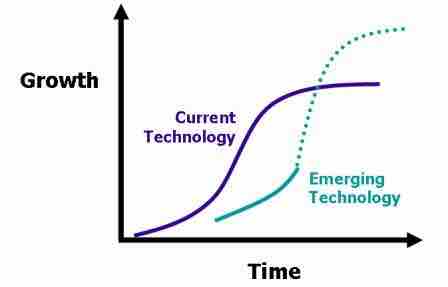Innovation is a primary source of competitive advantage for companies in essentially all industries and environments, and drives forward efficiency, higher productivity, and differentiation to fill a wide variety of needs. One particular perspective on economics isolates innovation as a core driving force, alongside knowledge, technology, and entrepreneurship. This theory of innovation economics notes that the neoclassical approach (monetary accumulation driving growth) overlooks the critical aspect of the appropriate knowledge and technological capabilities.
Scaling Technology
Technology in particular is a powerful driving force in innovative capacity, particularly as it pertains to both the evolution of innovations and the way they proliferate. Technology is innately scalable, demonstrating a consistent trend toward new innovations as a result of improving upon current ones. Product life cycles shows how economic returns go through a steep exponential growth phase and an eventual evening out, which motivates businesses to leverage technology to produce new innovations.
Technology Hubs

Technological Innovation Chart
This chart demonstrates the pattern of innovation over time. Note the overlapping trajectories of technologies: one product may dominate the market and grow at a high rate; the next ("emerging") product may start low while the other product is dominant but in turn grow to dominate the market even more thoroughly than the first, as technology and production are refined and improved.
The proliferation of innovation pertains to two important factors of technology driving innovation: the creation of geographic hubs for technology and empowerment of knowledge exchange through communication and transportation. Places like California's Silicon Valleya and Baden-Wurttenberg, Germany are strong examples of the value of technological hubs. The close proximity of various resources and collaborators in each hub stimulates a higher degree of innovative capacity.
Communication and cumulative knowledge in these technology hubs allows for these innovations to spread via technology to be implemented across the globe with relative immediacy. This spread of ideas can be built upon quickly and universally, creating the ability for innovation to be further expanded upon by different parties across the globe. Collaboration on a global scale as a result of technological progress has allowed for exponential levels of innovation.
Correlations Between Technology, Innovation, and Growth
Empirical evidence generates a positive correlation between technological innovation and economic performance. Between 1981 and 2004, India and China, developed a National Innovation System designed to invest heavily in R&D with a particular focus on patents and high-tech and service exports. During this timeframe, both countries experienced extremely high levels of GDP growth by linking the science sector with the business sector, importing technology, and creating incentives for innovation.
Additionally, the Council of Foreign Relations asserted that the U.S.' s large share of the global market in the 1970s was likely a result of its aggressive investment in new technologies. These technological innovations generated are hypothesized to be a central driving force in the steady economic expansion of the U.S., allowing it to maintain it's place as the world's largest economy.